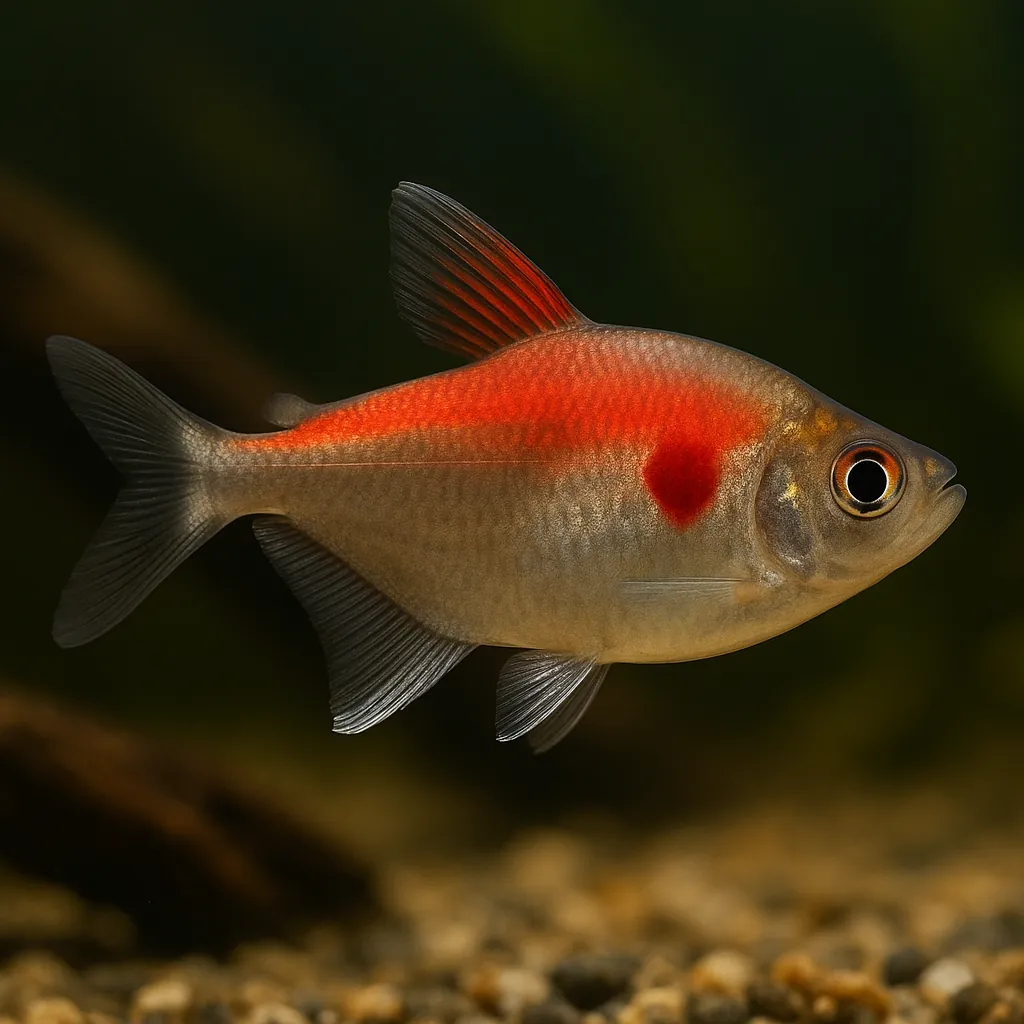
Redback bleeding heart tetra
Introduction
The Redback Bleeding Heart Tetra (Hyphessobrycon pyrrhonotus) is a captivating freshwater fish cherished by aquarists for its vibrant red back and distinctive "bleeding heart" spot near its gills. This species combines striking aesthetics with a peaceful temperament, making it an excellent choice for community aquariums. With proper care, these tetras can thrive, adding dynamic color and activity to your tank.
What makes the Redback Bleeding Heart Tetra stand out in an aquarium?
Their vivid red coloration and unique markings provide a stunning visual contrast, especially in well-planted tanks.
Are Redback Bleeding Heart Tetras suitable for beginners?
Yes, their hardy nature and straightforward care requirements make them ideal for both novice and experienced fishkeepers.
Care and Environment
Providing optimal care for the Redback Bleeding Heart Tetra involves replicating its natural habitat and maintaining stable water conditions.
What is the minimum tank size for a single Redback Bleeding Heart Tetra?
A minimum of 20 liters is recommended for a single fish, but they thrive best in groups.
What tank size is ideal for a group of Redback Bleeding Heart Tetras?
A 75-liter tank is ideal for a small school of 6 or more, offering ample swimming space and social interaction.
Maintain water temperatures between 23°C and 28°C, with a pH range of 6.3 to 7.6, and water hardness between 6 to 15°N. Regular water changes and efficient filtration are essential to keep the environment clean and oxygenated.
Incorporate dense vegetation, driftwood, and rocks to mimic their natural surroundings and provide hiding spots. A dark substrate can enhance their coloration, while moderate lighting replicates their native, slightly shaded habitats.
As omnivores, they accept high-quality flake or pellet foods, supplemented with live or frozen options like brine shrimp and bloodworms. Including blanched vegetables such as zucchini or spinach ensures a balanced diet.
Be mindful of their sensitivity to water quality; sudden changes can cause stress. Regular monitoring and gradual adjustments help maintain their health.
How often should I feed my Redback Bleeding Heart Tetras?
Feed them small amounts once or twice daily, ensuring they consume all food within a few minutes to prevent overfeeding.
Origin and Habitat
Native to the Amazonian River Basins in South America, Redback Bleeding Heart Tetras inhabit slow-moving streams and rivers with soft, acidic water and dense vegetation. These environments provide ample hiding spots and a rich food supply, contributing to their well-being.
What type of water bodies do they naturally inhabit?
They are found in slow-moving rivers and streams with abundant plant life and soft, acidic water conditions.
How does their natural habitat influence their care in captivity?
Replicating their natural environment with soft, slightly acidic water, dense vegetation, and gentle water flow helps them feel secure and exhibit natural behaviors.
Temperament and Compatibility
Redback Bleeding Heart Tetras are peaceful, schooling fish that thrive in groups of six or more. Their social nature reduces stress and encourages natural behaviors.
Can they be kept with other fish species?
Yes, they are compatible with other peaceful species like tetras, rasboras, guppies, and small catfish. Avoid aggressive or fin-nipping fish to maintain harmony.
Do they require a specific group size?
Keeping them in groups of at least six promotes well-being and natural schooling behavior.
Providing ample swimming space and hiding spots ensures a harmonious community tank environment.
Interesting Facts
Redback Bleeding Heart Tetras are known for their unique "bleeding heart" spot, a red marking near their gills that resembles a heart. Males often display more intense coloration and elongated dorsal and anal fins compared to females.
How can you distinguish between male and female Redback Bleeding Heart Tetras?
Males typically have more vibrant colors and longer fins, while females are rounder, especially when carrying eggs.
Is breeding them in captivity common?
Breeding is challenging but possible. They are egg scatterers; providing a separate breeding tank with soft, acidic water and fine-leaved plants can encourage spawning.
With proper care, these tetras can live up to five years, offering aquarists years of enjoyment.
Sources
All information in this article has been gathered from the following reputable sources:
Overview
Recommended Tank Size 19.8 Gallons (for groups of 6 or more) |
Minimum Group Size 6 |
Minimum Tank Volume 5.3 Gallons |
Maximum Adult Length 2 inches |
Average Adult Length 1.8 inches |
Shoaling (6+ required) Yes |
Preferred Water Type Freshwater, soft, slightly acidic |
Temperature Range (°C) 23–28 |
pH Range 6.3–7.6 |
Water Hardness (dGH) 6–15 |
Typical Lifespan (years) 5 years |